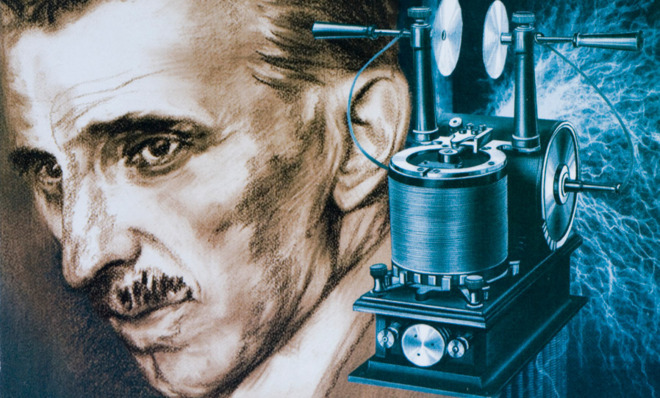Nikola Tesla, father of the death ray
The scientific genius imagined a high-energy beam that could "cause armies to drop dead in their tracks" from 200 miles away


"A mass in movement resists change of direction," inventor Nikola Tesla once said. "So does the world oppose a new idea."
However, eventually good new ideas tend to win out over resistance. Tesla was a visionary of his time — though many of his great dreams for harnessing the forces of nature would be deferred past his death in 1943. Here, we review some of Tesla's grandest visions, some of which have come true, and others — thankfully — have not yet been realized.
Vision: Alternating current for all
The Week
Escape your echo chamber. Get the facts behind the news, plus analysis from multiple perspectives.

Sign up for The Week's Free Newsletters
From our morning news briefing to a weekly Good News Newsletter, get the best of The Week delivered directly to your inbox.
From our morning news briefing to a weekly Good News Newsletter, get the best of The Week delivered directly to your inbox.
The "War of Currents" between Tesla's alternating current model of electric transmission and Thomas Edison's direct current got much uglier than most scientific disputes. Edison compared his DC system — where the electricity always flows in the same direction — to a peaceful river, but lambasted AC — where the current reverses direction anywhere from 50-60 times per second — comparing it to a violent torrent. Edison also electrocuted animals, most famously the Coney Island circus elephant Topsy, to demonstrate how dangerous AC was.
(More from World Science Festival: 5 legitimate scientific controversies)
Despite Edison's propaganda war, AC (bought from Tesla by the head of the Westinghouse Corporation) became the standard for long-distance electrical transmission simply because it worked more efficiently and cheaply. AC is preferable for use in the power grid because it's easier to change the voltage of the flow with transformers, allowing companies to easily raise the voltage from the power plant to the powerful main transmission line, and lower it for safe distribution to houses.
Direct current is still used in batteries and other low-voltage devices, and also survives in some parts of the grid: landline phone systems, household appliances, some computer data centers, and newer high-voltage DC cables.
A free daily email with the biggest news stories of the day – and the best features from TheWeek.com
Vision: Radio waves bearing global phone calls
Though the Italian Guglielmo Marconi is generally recognized as the inventor of radio, Tesla has some very legitimate claims to the title. As early as 1895, he had shown that he could receive and transmit radio signals with two Tesla coils resonating at the same frequency.
Tesla tried to take radio waves even further with his most Herculean labor: Wardenclyffe Tower, a giant towering dynamo that started construction in 1901. With it, Tesla thought, he could wirelessly transmit radio waves across the globe.
(More from World Science Festival: The long shadow of the Manhattan Project)
Once Wardenclyffe was operational, "it will be possible for a business man in New York to dictate instructions, and have them instantly appear in type at his office in London or elsewhere," Tesla told writers for the journal Wireless Telegraphy and Telephony. "He will be able to call up, from his desk, and talk to any telephone subscriber on the globe, without any change whatever in the existing equipment."
Vision: The smartphone
In that same interview with Wireless Telegraphy and Telephony, Tesla predicted that, with the advent of wireless broadcasting, people would eventually have on hand "an inexpensive instrument, not bigger than a watch, [that] will enable its bearer to hear anywhere, on sea or land, music or song, the speech of a political leader, the address of an eminent man of science, or the sermon of an eloquent clergyman, delivered in some other place, however distant. In the same manner any picture, character, drawing or print can be transferred from one to another place."
That's a pretty spot-on vision of the modern smartphone — though Tesla did fail to anticipate that businessmen and women would use this wondrous device to look at baby pandas sneezing, and argue about politics with strangers.
Vision: Wireless electric power
Wardenclyffe was not just planned to relay transmissions; Tesla also intended to use it to demonstrate that he could pull electricity from the air. Unfortunately, Tesla never got the chance to prove his concept of wireless electricity transfer; Wardenclyffe ran into a financial hole, and was dismantled in 1917.
(More from World Science Festival: Space junk: A graphic guide to our garbage up there)
But the dream of wireless power continues today. Massachusetts-based company WiTricity, the brainchild of a group of MIT scientists, is working on a wireless electricity transmission device that uses two coils of wire, coupled by a magnetic field that carries the electrical charge — a process known as electromagnetic induction. Another device, Powermat, combines electromagnetic induction with methods like radio-frequency identification. The Powermat is already popping up in the wild, with a rollout in Starbucks coffee shops planned throughout 2014 and 2015.
Vision: An all-powerful mega-death ray
This is one vision of Tesla's that we're a little relieved remains unrealized. In 1934, Tesla told journalists that he had devised an apparatus dubbed the Teleforce, which used a beam of concentrated particles to create a high-energy beam that could "bring down a fleet of 10,000 enemy airplanes at a distance of 200 miles from a defending nation's border and [could] cause armies to drop dead in their tracks."
Tesla said his aims were ultimately peaceful; he wanted a weapon to end wars. He provided a technical description of a charged particle beam device to various Allied nations in World War II. The USSR did try out an initial stage of testing, but the project eventually languished. Still, from the Cold War to this day, the U.S. military has also investigated particle beams as part of a ballistic missile defense system, but the project is still largely unrealized. One problem is that these types of particle beam weapons (which are kind of like open-ended particle accelerators firing streams of subatomic ammunition) have immense power needs; another problem is that particle beams can be affected by the Earth's magnetic field or the atmosphere.


